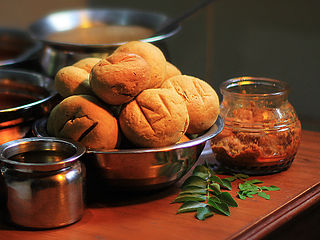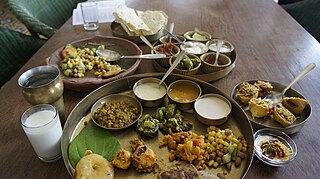Indian cuisine consists of a variety of regional and traditional cuisines native to the Indian subcontinent. Given the diversity in soil, climate, culture, ethnic groups, and occupations, these cuisines vary substantially and use locally available spices, herbs, vegetables, and fruits.

Punjabi cuisine is a culinary style originating in the Punjab, a region in the northern part of South Asia, which is now divided in an Indian part to the east and a Pakistani part to the west. This cuisine has a rich tradition of many distinct and local ways of cooking.

Bhakri is a round flatbread often eaten in the cuisines of the states of Gujarat, Maharashtra, Rajasthan, and Karnataka in India. The bhakri prepared using jowar or bajra is coarser than a regular wheat chapati. Bhakri can be either soft or hard in texture, unlike khakhra in respect to hardness.

A dhaba is a roadside restaurant in the Indian subcontinent, primarily across Pakistan and northern India. They are on highways, generally serve local cuisine, and also serve as truck stops. They are most commonly found next to petrol stations, and most are open 24 hours a day.

Tamil cuisine is a culinary style of Tamil people originating in the southern Indian state of Tamil Nadu and neighboring Sri Lanka. Meats, along with rice, legumes, and lentils, are also popular. Dairy products and tamarind are used to provide sour flavors. On special occasions, traditional Tamil dishes are served in a traditional manner, using banana leaves in place of utensils. After eating, the banana leaves are then used as a secondary food for cattle. A typical breakfast meal consists of idli or dosa with chutney. Lunch includes rice, sambar, curd, kuzhambu, and rasam.

Rajasthani cuisine is the cuisine of the Rajasthan state in North West India. It was influenced by various factors like the warlike lifestyles of its inhabitants, the availability of ingredients in an arid region and by Hindu temple traditions of sampradayas like Pushtimarg and Ramanandi. Food that could last for several days and could be eaten without heating was preferred. Scarcity of water and fresh green vegetables have all had their effect on the cooking. Signature Rajasthani dishes include Dal Baati Churma, Panchratna Dal, Papad ro Saag, Ker Sangri, Gatte ro Saag. It is also known for its snacks like Bikaneri bhujia, Mirchi bada and Kanda kachauri. Other famous dishes include Dal Baati, malaidar special lassi (lassi) and Lashun ki chutney, Mawa lassi from Jodhpur, Alwar ka mawa, Malpauas from Pushkar and rasgulla from Bikaner, "paniya"and "gheriya" from Mewar. Originating for the Marwar region of the state is the concept Marwari Bhojnalaya, or vegetarian restaurants, today found in many parts of India, which offer vegetarian food of the Marwari people. The history also has its effect on the diet as the Rajputs preferred majorly a non-vegetarian diet while the Brahmins, Jains, Bishnois and others preferred a vegetarian diet. So, the state has a myriad of both types of delicacies.

Baati is a hard, unleavened bread cooked in most areas of Rajasthan, and in some parts of Madhya Pradesh and Gujarat states of India. It is prized for its long shelf life and high nutritional content, and, in desert areas, for the minimal quantity of water required for its preparation. Baati is commonly eaten with dal, hence also referred to as dal baati. In some regions, especially Madhya Pradesh, it is also paired with a roasted aubergine mash called bharta. Baati is also closely related to Litti (cuisine), popular in eastern Uttar Pradesh (Varanasi) and western Bihar. Litti is eaten with potato, tomato and roasted aubergine.

Gujarati cuisine is the cuisine of the Indian state of Gujarat. The typical Gujarati thali consists of rotli, dal or curry, rice, and shaak. The thali will also include preparations made from pulses or whole beans such as moong, black eyed beans etc., a snack item (farsaan) like dhokla, pathra, samosa, fafda, etc. and a sweet (mishthaan) like mohanthal, jalebi, sevaiya etc.

Indian breads are a wide variety of flatbreads and crêpes which are an integral part of Indian cuisine. Their variation reflects the diversity of Indian culture and food habits.

Sindhi cuisine refers to the distinct native cuisine of the Sindhi people from Sindh, Pakistan. Sindhi cuisine has been influenced by Central Asian, Iranian, Mughal food traditions. It is mostly a non-vegetarian cuisine, with even Sindhi Hindus widely accepting of meat consumption. The daily food in most Sindhi households consists of wheat-based flat-bread (Mani) or rice accompanied by two dishes, one gravy and one dry with curd, papad or pickle. Freshwater fish and a wide variety of vegetables are usually used in Sindhi cuisine. Restaurants specializing in Sindhi cuisine are rare, although it is found at truck stops in rural areas of Sindh province, and in a few restaurants in urban Sindh.
Dal Bati Churma is the most popular dish in Rajasthani cuisine. It is made of three components of bati, dal, and churma. Dal is lentils, bati is a baked wheat ball, and churma is powdered sweetened cereal. Churma is a popular delicacy usually served with baatis and dal. It is coarsely ground wheat crushed and cooked with ghee and sugar. Traditionally it is made by mashing up wheat flour baatis or left over rotis in ghee and jaggery.
Bhojpuri cuisine is a style of food preparation common among the Bhojpuri people of Bihar and eastern Uttar Pradesh in India, and also the Terai region of Nepal. Bhojpuri foods are mostly mild and tend to be less hot in terms of spices used. The cuisine consists of both vegetable and meat dishes.

Churma is a popular Rajasthani, Bihari, Uttar Pradesi, Haryanvi, and Awadhi delicacy from India. In Punjab, the dish is called churi. It is coarsely ground wheat, crushed and cooked with ghee and sugar.
Bharunda is a village that comes under Sumerpur Tehsil in Pali district, Rajasthan. The Bharunda is an ancient village well connected to all surrounding villages and towns in the same vicinity.

Baigan bharta or Baigan Chokha is an Indian dish prepared by mincing grilled eggplant (baigan) and mixing it with tomato, onion, herbs and spices. Grilling the eggplant over charcoal or direct fire infuses the dish with a smoky flavour. Mashed eggplant is then mixed with cooked chopped tomato, browned onion, ginger, garlic, cumin, fresh cilantro, chili pepper, and mustard oil or a neutral vegetable oil. Traditionally, the dish is often eaten with flatbread and is also served with rice or raita, a yogurt salad. In Bihar and Uttar Pradesh, it is served hot with litti or baati.
Bihari cuisine is eaten mainly in the eastern Indian state of Bihar, as well as in the places where people originating from the state of Bihar have settled: Jharkhand, Eastern Uttar Pradesh, Bangladesh, Nepal, Mauritius, South Africa, Fiji, some cities of Pakistan, Guyana, Trinidad and Tobago, Suriname, Jamaica, and the Caribbean. Bihari cuisine includes Angika cuisine, Bhojpuri cuisine, Maithil cuisine and Magahi cuisine.

Andhra cuisine, culturally known as Telugu cuisine, is a cuisine of India native to the state of Andhra Pradesh and is the culinary style of Telugu people. It is generally known for its tangy, hot, and spicy taste.

Malaysian Indian cuisine, or the cooking of the ethnic Indian communities in Malaysia, consists of adaptations of authentic dishes from India, as well as original creations inspired by the diverse food culture of Malaysia. Because the vast majority of Malaysia's Indian community are of South Indian descent, and are mostly ethnic Tamils who are descendants of immigrants from a historical region which consists of the modern Indian state of Tamil Nadu and Sri Lanka's Northern Province, much of Malaysian Indian cuisine is predominantly South Indian inspired in character and taste. A typical Malaysian Indian dish is likely to be redolent with curry leaves, whole and powdered spice, and contains fresh coconut in various forms. Ghee is still widely used for cooking, although vegetable oils and refined palm oils are now commonplace in home kitchens. Before a meal it is customary to wash hands as cutlery is often not used while eating, with the exception of a serving spoon for each respective dish.
Katt Bafla is a popular and traditional dish from the Bundi district of Hadoti region in Rajasthan, India. It is a famous dish across the north Indian states in India. Traditionally this dish is made on every occasion in Rajasthan. In this dish Bafla is a type of spherical wheat bread whereas the Katt is a type of Barfi made with a mixture of unsalted wheat bread coarse powder with ghee and jaggery powder. Traditionally this dish is served with Daal and Kadhi.
















